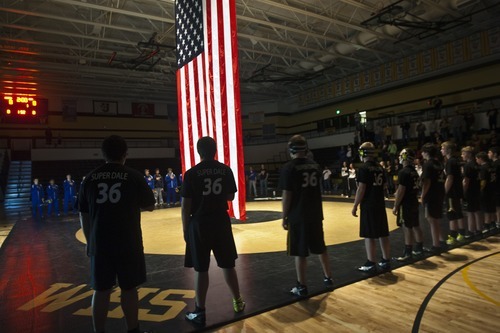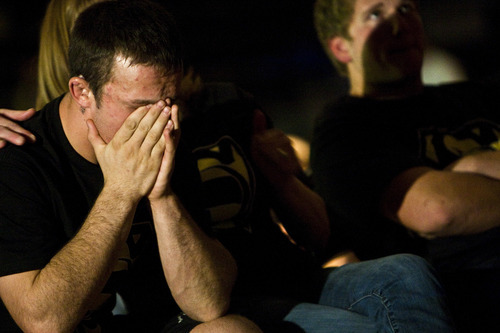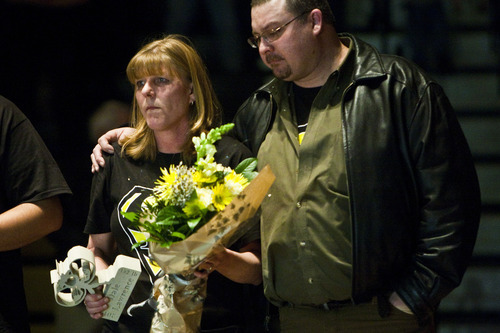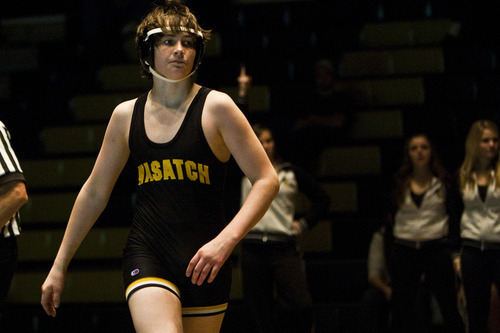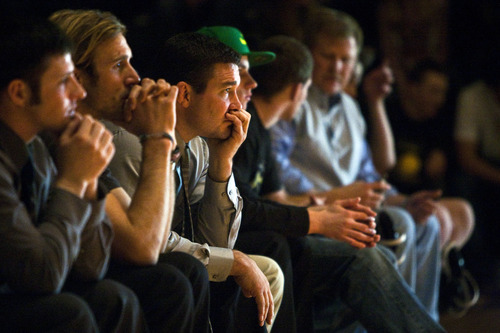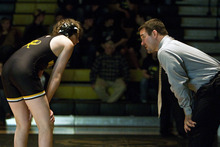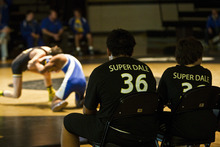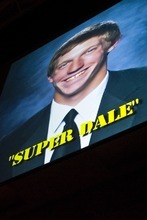This is an archived article that was published on sltrib.com in 2011, and information in the article may be outdated. It is provided only for personal research purposes and may not be reprinted.
Heber City • They call him "Super Dale."
The people in this mountain town all know Dale Lawrence. He's the funny kid on the wrestling team. The nice one whose grin is gapped, goofy and unvarying.
"He's really just a kid that spreads goodness around him," Wasatch High Principal Paul Sweat said.
They call him Super Dale for a reason. As a running back on the Wasatch football team, Lawrence smeared a strip of eye black across the top half of his face. It looked like a superhero's mask, senior Tyson Kohler said, and the nickname stuck.
In practice on Jan. 4, Lawrence was wrestling a teammate in a 20-second drill. Coach Wade Discher told the wrestlers to imagine that the state championship was on the line. As Lawrence tried to escape a basic hold called the ball and chain, however, his neck contorted and his C4 vertebra snapped into his spinal cord.
"He was just laying there," said sophomore Aryan Shibonis, "not moving."
Paramedics came and the wrestling room in the high school's basement was cleared. The team didn't know how serious Lawrence's injury was until Discher sent them a text message a couple of hours later.
Super Dale was going into surgery. And he was paralyzed from the neck down.
—
"Brotherhood" • The people of Heber City know wrestling. They watched Olympian Cael Sanderson come of age and emerge as one of America's premier athletes. Their Wasps have won 18 state championships, most recently in 2008.
"Probably not too many kids across the community haven't been on a mat," said Steve Sanderson, a Wasatch High assistant principal and Cael's father.
In the six decades Wasatch has been a state wrestling powerhouse, there have been plenty of injuries: dislocated joints, shoulder separations, the occasional broken bone and torn muscles. But people who know the sport will tell you wrestling is relatively safe.
From 1982 to 2009, high school wrestlers in the United States suffered 59 brain, skull or spinal-cord injuries, according to the National Center for Catastrophic Injury Research at the University of North Carolina. By comparison, 699 football players had similar injuries within that same time frame.
After Lawrence's injury, parents started calling the school, wondering if it was appropriate for their children to keep wrestling.
"It makes you think," Sanderson said. "I ran all of my kids through the wrestling program, and they were in that same position 100 times. A thousand times. Were we just lucky they landed differently?"
But the Wasatch team didn't want to quit. They wanted to be strong for Lawrence.
"I didn't feel like going to practice the next day," said Discher, a stout former college wrestler with deep-set eyes and a neatly trimmed black goatee. "But the kids, that's where their comfort is. That's their brotherhood."
Doctors have told Lawrence's family to brace for the worst. It's possible he will remain paralyzed for the rest of his life, though there have been moments of hope. Last week, Lawrence felt a sensation in his arm and, on Thursday, in his feet.
The Saturday after he was injured — after the team won a tournament at Mountain View High School — Discher took Lawrence's teammates to Utah Valley Regional Medical Center.
The coach tried to warn his team that Super Dale didn't look good. He was on a feeding tube and was sedated.
The wrestlers carried the trophy they won at Mountain View to Lawrence's room. When Juan Espinoza, a freshman whom Lawrence tutored, saw his mentor, he broke down.
"My buddy!" he exclaimed, sobbing. "My buddy."
—
One missing • Eight chairs were turned to face a large white projector screen Thursday night in the big gym — "The Nest" — at Wasatch High School. At the last home meet of the season, an eventual win against Orem, it was time to honor the team's seniors.
There was a chair for each of the eight.
Seven walked out: Kohler, Tyler Mair, Tanner Sweat, Cristian Payan, Chris Hortin, Jake Provost and Gerritt Bradley. Between Kohler and Mair sat Kelly Giles, Lawrence's mother, herself a Wasatch graduate. They each wore a black T-shirt with a Superman logo on the front, the "S" braided through a thin "D." On the back, the shirts, designed by a pair of Wasatch students, was "Super Dale."
The lights dimmed and a video began to play, cycling photos of each of the seniors as they came of age. There was Bradley with a mullet; Sweat as a toddler, wearing nothing but a diaper and a ski mask. Then the music stopped, and Discher's voice piped through the gym, asking the audience to honor the one missing senior.
"We love you, Dale," Discher said. "May you always remain Wasatch strong."
Discher recorded the message earlier Thursday. He said he had to start over four times before he could get through the short script without choking up.
Lawrence's face appeared against the backdrop of "Kryptonite," by the band 3 Doors Down. There he was as a newborn baby, a mischievous boy in a football jersey, a young fisherman, a martial artist. A wrestler.
The song played: "Will you still call me Superman?"
An old school photo faded from the screen and was replaced by one taken that very day. Lawrence lay in his hospital bed, a tube running to his nose.
The audience stood and applauded as Giles hugged the wrestlers around her and wiped her eyes. In the photo, Lawrence had raised his eyebrows, parted his lips and unfurled a familiar smile — gapped, goofy and unvarying.
boram@sltrib.comTwitter: @oramb —
Help for 'Super Dale'
• On Feb. 7, Wasatch High School will host a dinner and benefit auction for Dale Lawrence's family. People who would like to attend should contact Wasatch High School at 435-654-0640. People or businesses who would like to donate items can contact Jason Watt at jason.watt@wasatch.edu or 435-654-0640. More information on fundraisers will be posted at http://www.wasatch.edu/whs.


